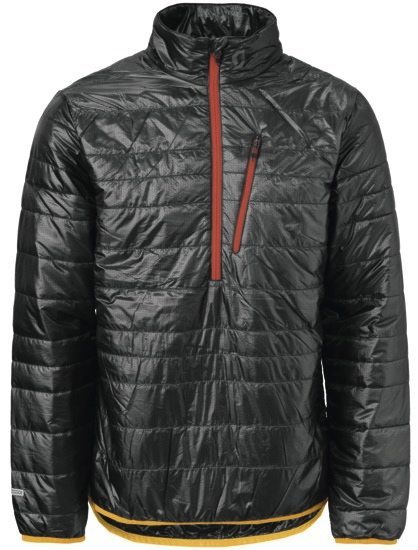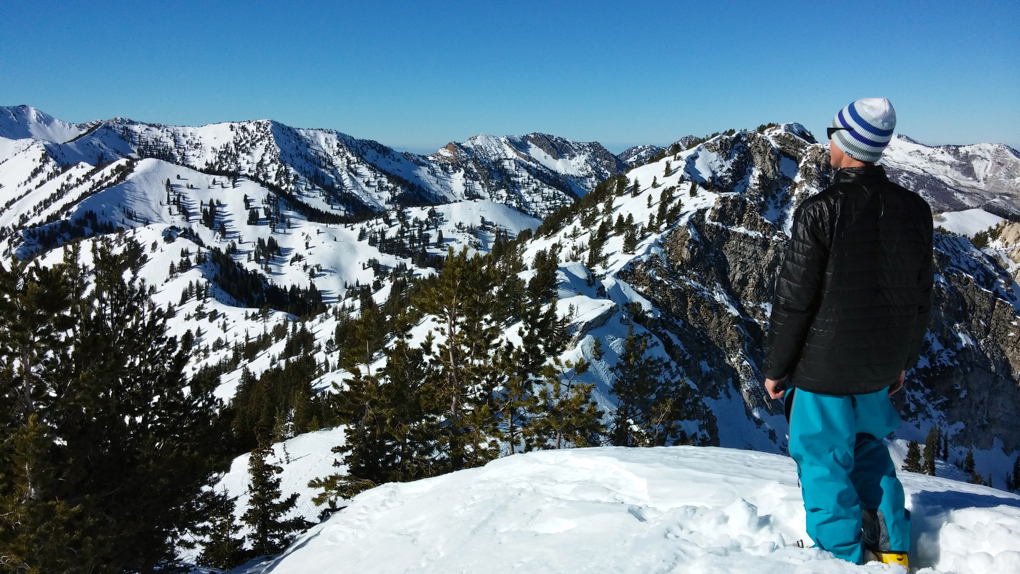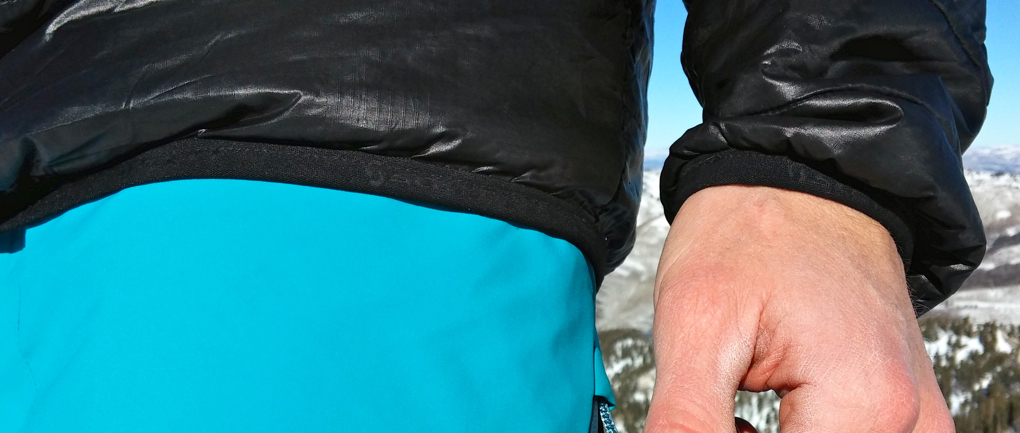
Scott Komati Jacket
Size: XL
Fit: Athletic
Blister’s Measured Weight: 243 g / 8.57 oz
Type: Ultra-lightweight Insulator
Features:
- Ultralight 15d Ripstop shell fabric
- DRYOzone DWR (durable water-repellent)
- Primaloft® ECO 60g insulation
- Zippered chest pocket
- Chest pocket doubles as stuff sack
- ½ Zip
- Lycra® binding around cuff and hem
MSRP: $175
Days Skied: ~35
Days Worn: 80
Test Locations: Alta Ski Area, Taos Ski Valley; Wastch and Taos Backcountry, Park City Mountain Resort, all around the Salt Lake Valley
Reviewer Info: 6’, 160 lbs.; Sleeve length: 37-38”; Torso Length: 18”
The Scott Komati Jacket is part of Scott’s “all-year-round” collection, so it’s supposed to be versatile enough to be used all 12 months of the year. Featuring Primaloft® Eco insulation, the jacket will likely keep you warm as the thermometer readings start to fall, and may keep your environmental conscience clear for a little while. I’ve spent most of the fall and winter wearing the Komati quite regularly, here’s what I’ve come to find so far.
Fit / Sizing
My frame is a difficult one to fit properly. I am lean for my height, have an average length torso, and very long arms. To accomodate those long arms and my taste for loose-fitting clothing, I typically wear an extra-large in any item with full-length sleeves. I hate feeling restricted.
And just like the Scott Decoder Jacket I reviewed last season, the Komati fits me very well.

Although the Komati uses a 100% nylon shell (unlike the Decoder, which uses Polartec Powerstretch fabric over the arms) I can still reach my arms straight out in front of my body without the sleeves pulling halfway up my arms, and I can also pull the sleeves over my hands on a cold morning dash from my car to the train when heading to school.
The torso length, aided by a slight drop tail, is plenty long enough to tuck into my ski pants and forget about; I don’t constantly have to fidget around to re-tuck. The length is also adequate when hunched over the handlebars of my mountain bike, keeping the lower portion of my back covered.
The sleeve cuffs and hem terminate with a ring of stretchy Lycra to help seal in heat and keep out cold. At both the sleeve and hem, I feel like the diameter of this ring could be a touch smaller to help with the intended goal. This would be especially beneficial at the bottom of the jacket, since the Komati does not feature a drawcord hem, just the Lycra seal. (Granted, those in need of an XL who have a larger waist than me probably won’t have any issue here.)

The Scott Komati runs true to size. The “athletic” fit should not be confused with “slim” fit, and from Jonathan’s description of the Patagonia Ultralight Down Hoody, the Komati fits very similarly: “neither baggy nor restrictive.”
Warmth/Breathability
The Komati incorporates the same 60g Primaloft Eco insulation (which uses post-consumer recycled bottles for insulation) as the torso of the Decoder, but with the Komati, the insulation is used throughout the entire jacket. I found the Komati to be noticeably warmer than the Decoder both while being active, and once I stop moving. Neither jacket is exceptionally warm when standing around in the cold, but I have felt comfortable waiting 10-15 minutes for the train with temps as low as 35°F, with only a t-shirt underneath.
The bottom line here is that the Komati is exactly what it is – a light insulator. If you are looking for a less stripped-down lightweight insulator that is also very warm (but less packable), I’d suggest reading Jonathan’s review of the Patagonia Ultralight Down Hoody. While skiing at the resort, I have been quite comfortable in the Komati with temps above 25°F in all of my shells this season.
As the Scott description says, “The Komati is perfect for anything the outdoor life can throw at you: desert mornings, afternoons in the high alpine, or an après beer in town.” You will notice there is no mention of arctic adventures, or epic sweat fests.
Speaking of sweat, the Komati isn’t as breathable as the Decoder or other lightweight fleeces, but I still haven’t noticed the inside of the jacket feeling damp at all, just that it’s easy to build up a lot of heat. I have found myself adjusting the chest zipper to dump that excess heat while skiing on a warm day or while out on a bike ride more than I did with those other options.
The ½ length chest zipper does a great job of venting the jacket, so you can be very active in the Komati in fairly warm temps. I’ve worn the Komati under the Oakley Unification Pro jacket this past week for instance, skiing with the temperature just above 40°F, and with the zipper open about half way, my temperature felt well regulated both while skiing and while riding the lift.
One last note: the Komati doesn’t have a hood. If you’re looking for a similar weight jacket from Scott with a hood, I’d suggest looking at the Decoder.
Packability
The Komati stuffs into the only pocket of the jacket: the zippered chest pocket. By simply opening the zipper, pulling the pocket lining outside of the jacket, stuffing the jacket into the lining, and closing the zipper, the Komati packs into roughly the size of a 32oz Nalgene. It can also squish down much smaller (about half that size) when it needs to be jammed into a full backpack or suitcase. Packable? Absolutely. +1 for Scott’s “stripped-down” design.
Pockets
As I just mentioned, the Komati has only one pocket, which can be found on the chest. The pocket is perfect for a cell phone or candy bar, plus a couple small items like a drivers license and debt/credit card. I didn’t find that it took much in that pocket, however, to become an annoyance in how the added weight shifted the jacket around, tugging down on the left side.
The major downside of just one pocket is, of course, the fact that…there is just one pocket. On multiple occasions while standing around waiting for the train to school, I really wished I had two hand pockets to help keep my digits warm. Instead, I had to resort to pulling my hands up into the sleeves to shelter them from the cold. (A drawback of that stripped-down design.)
Durability
The Komati has been my go-to jacket for most of the fall and early winter—wearing it both as a mid-layer and outer-layer—and it still looks like new. All of the seams look as good as when the jacket came out of the plastic bag, the nylon fabric hasn’t snagged or torn, the zippers work perfectly, etc. I’ll update this section if I run into any issues.
Bottom Line
After months in the Komati jacket I’ll vouch that Scott’s product description matches the jacket perfectly. It is incredibly lightweight, packs down very small, and is a comfortable, light insulator. I’ve been equally happy wearing it out skiing as a mid-layer when the temps aren’t artic-like; out riding my mountain bike on cool fall days; or all day long while I’m at the University of Utah.
